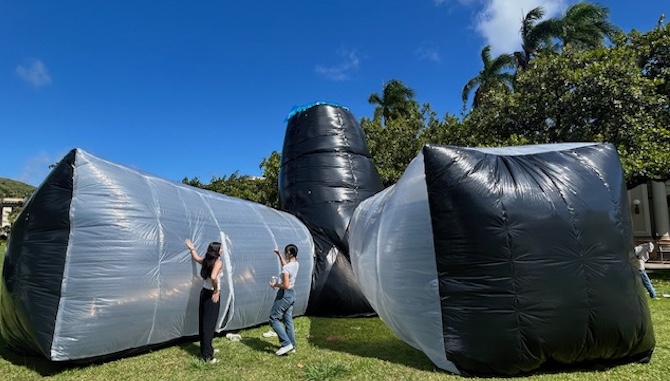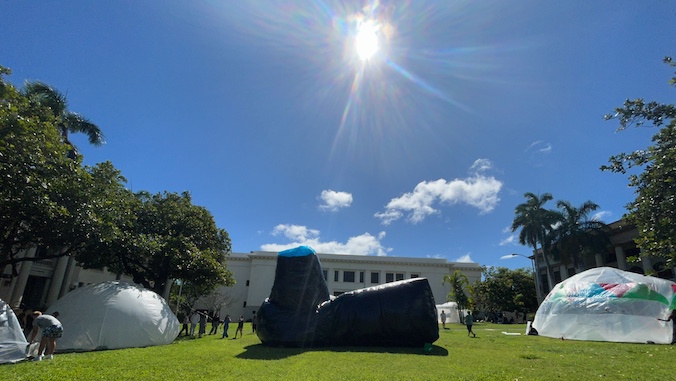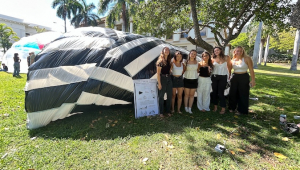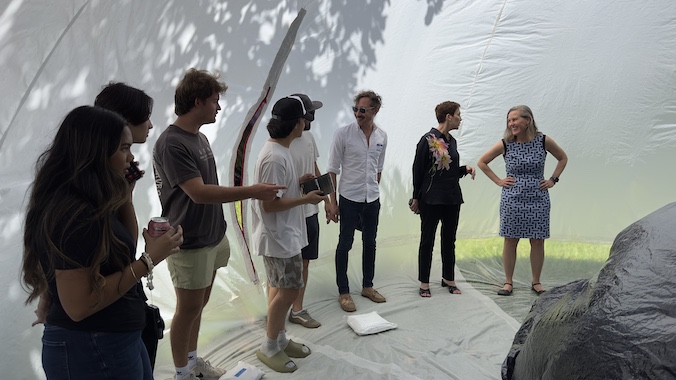

The lawn between the School of Architecture and Hawaiʻi Hall, the University of Hawaiʻi at Mānoa’s historic Quad, was overtaken by towering, walk-through inflatable structures on May 6. The occasion? The School of Architecture’s annual Inflatables Installation, a full-scale exhibition by first-year students exploring how air-powered design can meet real-world needs.

This year’s theme, “Temporary Emergency Space,” challenged 85 students across 12 teams to create deployable structures that could serve as emergency shelters, triage zones, or community gathering hubs. Over three weeks, students fabricated their designs using plastic sheeting, tape, and fans, resulting in an immersive public showcase.
Inflatable architecture, also known as pneumatic structures, has real-world applications such as field hospitals during the COVID-19 pandemic and rapid-deploy shelters in disaster zones.
“Students work in teams, plan in detail, and troubleshoot everything from seam design to inflation logic,” said Associate Professor Lance Walters. “They’re learning architecture not as a static object, but as a system of materials, people, forces and experiences.”
From concept to large-scale prototype

“I was really excited to see all the hard work we put in come to life,” said Bri Bissett, a first-year student whose team designed Cozy Cone, a three-winged inflatable space. “Each wing has its own purpose—one for medical care, one for relaxation, and one for reuniting with loved ones. The winds gave us some trouble, but tape was our best friend!”
The annual installation marks the final project for ARCH 102, a first-year design studio. It gives students the opportunity to apply foundational lessons of spatial thinking, construction logic and collaboration.
“Razzle Dazzle is our inflatable camo cone, a spot for soldiers to regroup, plan, or just catch their breath,” said freshman Ava Blasy. “It was surprising seeing it actually stand up after all our work!”
A tradition of creativity with purpose
The Inflatables Installation has become a much-anticipated tradition at UH Mānoa, drawing attention not only for its visual impact, but also for how it encourages young designers to connect their projects to broader social and environmental issues. Past events have included themes such as intervention, the moon, and the Arctic. This year’s theme was inspired by faculty collaboration with Professor Bundit Kanisthakhon, who is researching alternative emergency shelters.
Newly appointed architecture Dean Mo Zell, who joined UH Mānoa three weeks ago, visited the event and noted the creativity and care the students brought to their work.
“Inflatables are not just a novelty—they’re a serious design medium for thinking about: how quickly we can create space, what it means to occupy space temporarily, and how architecture can respond immediately to human need,” said Walters.


